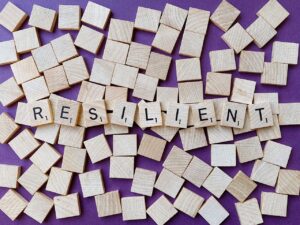This article was first published in the Globe and Mail. I also bring this topic and related themes to workshops, talks, and presentations.
—
The pandemic roller coaster continues. Two steps forward, and a couple back. As we phase into the next stages of reopening and its implications for life back at work, there are questions, uncertainties and concerns.
Will I be safe commuting? Will I lose my autonomy and freedom when back at the office? As a leader, how do I bring my team together – many of whom have never been together before? And so on. All this and a war happening far away but so close to our own hearts and concerns.
If you are feeling overwhelmed, uncertain and even a bit helpless, you are not alone. We are all in some ways feeling the impacts of our world in flux.
As I wrote in my last column, we’re not done with that resilience thing just yet. We’ll need more of it. With ample ways to fuel up our resilience, here are just a few starting paths to help bolster up resilience for yourself and others at work.
- Recalibrate, don’t forego essential human needs
Needs are needs, in good and tough times. Some are universal, and some are unique to our own individuality. They impact our physical, mental, emotional and social well-being – they all matter. When we forgo our essential needs, we just aren’t the same.
When we can’t do “that thing” the way we did it before, we must recalibrate and find new ways. Can’t go the gym? Create one at home. Can’t connect physically? Zoom will do.
We’ve been trying. And we must continue trying. Mastering our recalibrating skills will go a long way as the world continues to flux.
I’ve been partnering with an organizational client these past months to engage their staff in a resilience-discovery program. Our aim has been to give people more tools and agency to fuel their personal resilience, and to connect with others doing the same. They have been experimenting and reconnecting with parts of themselves forgotten – as human beings, not just their working roles – and sharing their experiences together.
Conversations where people can connect on their challenges, learn together and share bright spots and opportunities can be a powerful path to individual and team resilience.
Connection, safety and belonging are essential human needs. As human beings, we don’t just crave social connection – we require it. It is a hard-wired, primal human need that keeps us alive – and on many levels, safe. Any conversation that fosters togetherness at work will go a long way.
In planning for the back-to-work phase, leaders must continue to recalibrate in finding ways to foster connection, safety and belonging. There isn’t just one way, nor another to meet these needs. There could be many. It can start with conversations and tiny moves.
- Tiny can be big
It’s amazing how small moves can be so positively powerful. A good night’s sleep makes a world of difference. A bit of nature during the day can restore one’s energy.
A gesture of compassion and care for another can heal and elevate trust. A leader’s friendly check-in chat can create safety and assurance.
Whether as an individual and/or a leader, think of meaningful small moves you can make. They may yield rather big results.
- Challenge mindsets. Thought is not always a reliable compass for what is true, helpful or possible
Another helpful path is to not believe everything you think! Apparently human beings have about 6,200 thoughts a day. Our brains tend to hold on to the negative thoughts – a survival mechanism. But in modern day challenges, too much negativity can deplete our resourcefulness, creativity and resilience.
We can recalibrate this by intentionally becoming more aware of the good – even amidst the tough stuff. Engage in questions and habits that help you account for the good. What went well? What good is in this bad? What are we hopeful and/or grateful for? And what can we do that is in our control and influence?
- Focus on what you can control, and do what you can do
When we focus on what is out of our control and what we can’t do, our brains spiral into negative territory and narrow, which depletes energy, resourcefulness and resilience. Practice focusing on what you can control or at least influence, and what you can do even if there’s a lot you can’t. Spiral up on what’s possible.
- Kindness, generosity and compassion are superhighways to resilience for self and others
Whether consciously or not, we can be hard on ourselves and on others too, especially when stressed. Kindness, generosity, and compassion can elevate resilience for the giver and the receiver.
With ample opportunity in these tough times, even tiny acts of kindness can spiral up the giver and the receiver. Practice making positive assumptions before negative judgments. Amplify compassion and curiosity for those who falter, including yourself. Be a caring leader and/or colleague who lifts people up. And you’ll lift too.
- Remember to remember
There is nothing difficult, vastly new about any of these strategies, but as human beings, we tend to forget. Thus, this is the most important strategy. Remember to remember.
How will you remember to remember?
Eileen Chadnick PCC, of Big Cheese Coaching, works with organizations and leaders (emerging to experienced), navigating on leading and flourishing in times of flux, opportunity and challenge. She is the author of Ease, Manage Overwhelm in Times of Crazy Busy.


0 Comments